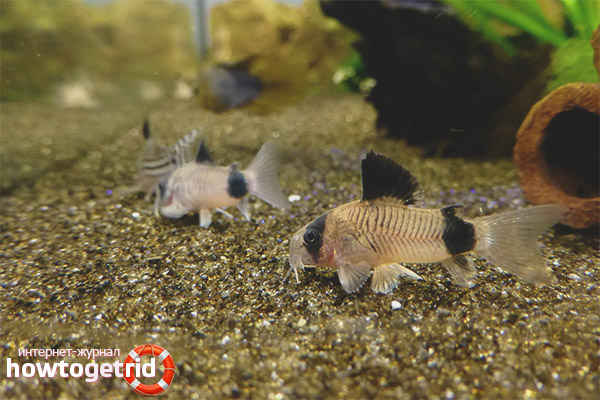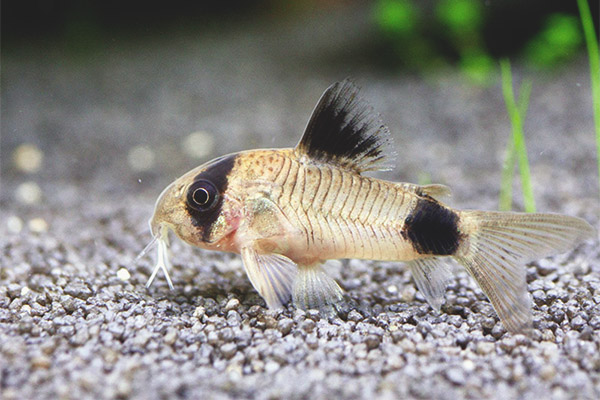The content of the article
Aquarium fish species of the Corridor Panda are sometimes called catfish pandas. In Latin, their name sounds like Corydoras panda. These original fish come from South America. They can be found in countries such as Peru and Ecuador.
Corridor pandas live in rivers. There are a lot of them in the Rio Whipped River. This river is one of the tributaries of the great Amazon. In addition, it is found in Rio Amaril, as well as in Rio Aqua. The water in all these rivers is sour and soft. The flow in them is slow. Compared to other rivers in this area, the temperature of the water is lower.
The first description of this species is dated 1968. These recordings were made by the scientist Randolph Richards. But the species got its name only in 1971. It was given thanks to the interesting color of the fish, which resembles the coloring of a panda. Representatives of this species of fish also have a light body, and there are circles around the eyes.
Due to their original appearance, these fish quickly became very popular among aquarists. They became especially famous when they learned to breed this species in an aquarium.
Description
As already noted, these fish are very similar in color to the panda. That is why they have such a name. Their body is light, but sometimes there are individuals with a slightly pinkish tinge. On the body there are three black spots. The spot on the head of the fish frames its eyes. This sign prompted scientists to give the catfish such a name. The second black spot is located on the dorsal fin of the corridor. The third spot is located near the tail fin.
There are other types of aquarium fish, which belong to the genus corridor. They all have three pairs of mustache. In size, these fish are small. Usually they can grow only up to 5.5 cm. At the same time, males are smaller than females, and not so rounded. Very interesting is the voile catfish panda. Its difference is that it has longer fins.
Content
The pandas' corridor can live in both cool and warm water, as the temperature, which is customary for them in the wild, ranges from 16 to 28 degrees. This feature distinguishes these fish from many tropical fish. Catfish panda can even transfer water that has cooled down to 12 degrees. This is due to the fact that during the melting of snow the temperature of the water in the river can fall and so much. But with the aquarium content such experiments are best not to conduct, as this can lead to fish in the disease.
When kept in an aquarium, it is important to take into account that the panda corridor is used to living in water that contains almost no minerals. It is very soft, can be neutral or slightly acidic. To make the fish feel as comfortable as possible, they hurt less and live as long as possible, it is advisable to recreate their usual habitat conditions.This is especially important for those aquarists who want to breed this catfish.
Like the rest of the corridor family, this catfish needs to provide clean water, the parameters of which remain stable. Therefore, it is imperative that water is constantly cleaned. For these fish, it is necessary to provide acidified or neutral water. It should also be remembered that the water temperature should be lower than for many other fish. These cute fish will feel best at a temperature of 22 degrees. But today in pet stores you can purchase corridors that are used to warmer water.
When arranging an aquarium, preference should be given to a shallow, soft ground. It may consist of sand or fine gravel. It is important that in the aquarium was more vegetation. Indeed, in the wild, these fish live in rivers with lots of algae. When choosing a decor you need to choose such elements that can serve as a good shelter for fish. It can be caves, snags, stones. Corridor loves shade very much, so it is desirable that the plants be large. You can also pick up floating algae.
To date, there is no data on the life expectancy of the catfish. If we assume that it approximately coincides with the duration of other members of the genus, then it is about 10 years.
Compatibility

A positive feature of this fish is its livability. She does not show any aggression to her aquarium neighbors. To keep them you need a flock, consisting preferably of 10-15 individuals. But, if it is not possible to provide them with the necessary space, then you can get by with 3-4 fish. These catfish belong to the gregarious fish. They always move in groups. Since the corridor of the pandas are small, it is not recommended to move the larger predators to them. Otherwise they may become their victims. You should not keep them together with Sumatran barbs. These fish can break off fins catfish.
Best of all, tetras, danios, rasboros, as well as the rest of the haracin fishes are suitable for them as neighbors. Very well they will feel in the neighborhood with any other corridors.
Feeding
Representatives of this species are omnivorous fish, so their feeding should not cause difficulties even for inexperienced amateurs.
These catfish are referred to as bottom fish, so they are accustomed to eat everything that falls to the bottom of the reservoir. If you keep a rather large flock of these fish, it is very important when feeding to make sure that the food is enough for each individual. The ideal feed option for this species will be special pills designed specifically for catfish. Such feeding will be very convenient for the owner himself. At the same time, the pills will provide these fish with all the necessary substances. For variety, catfish can be given live frozen food. They love moth and daphnia very much. These fishes belong to night species. In nature, they feed and are active at night. Therefore, it is better to feed them after sunset or in the dark.
Sex differences
Breeding
If you decide to breed this species yourself, remember that this business will be difficult.But, if there is a desire and perseverance, you can achieve results. When spawning, it should be planted with moss having small leaves. This may be java moss. It is here that a couple of these catfish and lay caviar. At that time, the couple should eat only live food. In order for the fish to start spawning, it is necessary to reduce the temperature of the water by running a certain amount of cold aquarium. This is due to the fact that spawning in the wild begins during the beginning of the rainy season.
Video: aquarium catfish corridor panda











To send